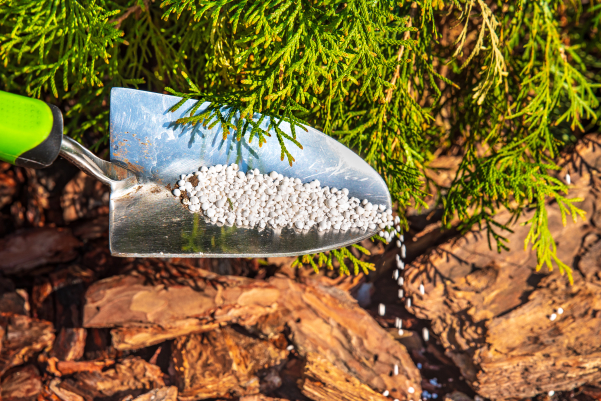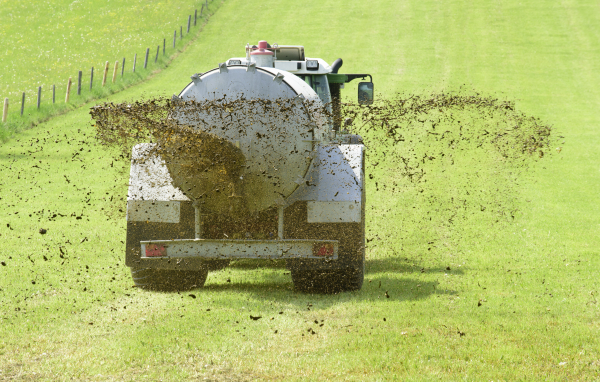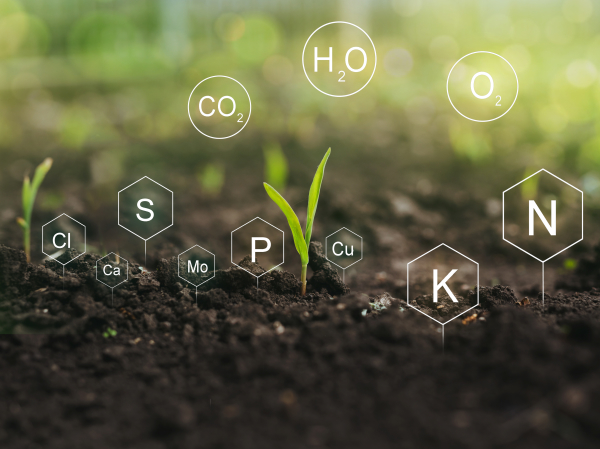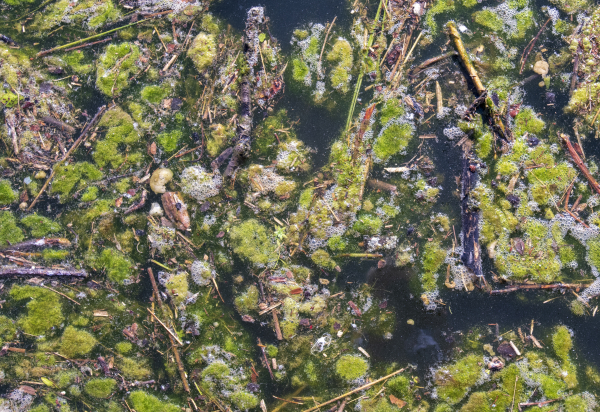Fertilisers are substances and mixtures of substances that increase the supply of nutrients in the soil for plants, resulting in higher yields and faster plant growth. This serves to ensure an adequate supply of nutrients for the population.
What fertilisers are made of
There are five main nutrients in fertilisers:
nitrogen (N), phosphorus (P), potassium (K), calcium (Ca) and
magnesium (Mg). A deficiency of any of these nutrients can limit plant growth. These fertiliser components are offered separately or in mixtures that should meet the requirements of the respective crops as much as possible. Fertilisers that contain both nitrogen, phosphorus and potassium are called NPK or complete fertilisers.
Types of fertiliser
Fertilisers are generally differentiated according to the way in which the fertilising substance is bound. Further distinctions are the form of the fertiliser (solid fertiliser and liquid fertiliser) and their effect (fast-acting fertiliser, slow-release fertiliser, depot fertiliser).
Mineral solid fertiliser
In inorganic or mineral fertiliser, with the exception of liquid ammonia fertiliser, the fertilising elements are usually present in the form of salts; they are therefore available in granulate or powder form. Many nutrient elements can be mined from fossil deposits. However, they are present in the rock as stable, hardly soluble compounds. Plants, however, only absorb nutrients in the form of ions dissolved in water. For this reason, rock phosphates, for example, must be "digested" (Haber-Bosch process; phosphate digestion).

Mineral fertilisers have enabled a great advance in productivity in agriculture and are used very frequently. A negative aspect of synthetic fertilisers is the enormous amount of energy required for their production. Mineral phosphate fertilisation also leads to an accumulation of the toxic and radioactive heavy metal uranium in the soil and thus in the food chain, since phosphate and uranium are chemically closely bound to each other. In addition, there is an accumulation of the equally toxic heavy metal cadmium, which enters the human food chain via the plants.
Nitrogen fertilisers are mostly ammonium nitrate, ammonium sulphate and potassium nitrate and are produced from ammonia and nitric acid.
Phosphates are basically used as raw phosphates or as digested phosphates. Since rock phosphates are poorly soluble, they are digested with sulphuric acid or phosphoric acid. After digestion with sulphuric acid, they are called superphosphate, while after digestion with phosphoric acid they are called double or triple phosphate.
Potassium salts are extracted in mines, processed (potassium chloride fertiliser) or converted to potassium sulphate.
Fertilisation with gaseous carbon dioxide (CO2) is an important application in greenhouse horticulture. The reason for this is the lack of CO2 caused by photosynthetic consumption when there is an insufficient supply of fresh air, especially in winter when ventilation is closed, because plants need CO2 as a basic substance. Carbon dioxide is introduced either directly as a pure gas or as a combustion product from propane or natural gas (coupling of fertilisation and heating).
Organic fertilisers
In organic fertilisers, the fertilising elements are bound to carbon. Organic fertilisers are usually of animal (waste materials such as liquid manure, slurry, guano, etc.) or plant origin, but can also be synthesised (e.g. urea). They have a more long-term effect and are often washed out less quickly than minerals. One indicator of the speed of action is the C/N ratio - the ratio of carbon to nitrogen. The higher the ratio, the slower the effect of the fertiliser.

Mineral nutrients and their use
Nutrient uptake by plants
When it comes to mineral nutrient uptake from the soil, a distinction must be made between the nutrition of summer and winter species and perennial plants:
- For summer species (e.g. potatoes), depending on the length of the growing season, the demand for nutrients increases rapidly up to a certain point before maturity and then drops or stops altogether.
- For winter species (e.g. winter cereals or rape), winter dormancy (frost) interrupts nutrient uptake.
- Perennial plants with perennial underground organs, e.g. grasses, clovers, hops and vines, store nutrients in their roots and use these reserve substances to accelerate development in the following spring.

Uptake of fertiliser by soil solution or leaves
Nutrient uptake from the soil solution
The plant takes up the nutrient salts with the roots from an aqueous solution. They are present in the soil solution as electrically charged particles (ions). In addition, the plant nutrients iron, manganese, copper and zinc, which are difficult to obtain in the soil, can form water-soluble chelate compounds with organic substances and be taken up by the plants in this form. The quantitative nutrient uptake of the plant depends on the performance of root respiration. Easily heated soils with a favourable air-water balance offer the best conditions for nutrient uptake.
Nutrient uptake by the leaf
The leaves of a plant can also absorb water and the substances dissolved in it through small pores. For years, the supplementary supply of nitrogen, magnesium and trace nutrients through the leaf has proven itself in practical cultivation. The advantage of this method of targeted nutrient supply is the high degree of utilisation, but the supply of nutrients per application is limited.
Dangers of overfertilising
If too much fertiliser is applied, there is a risk that the soil will be over-fertilised and thus adversely changed. This can be detrimental to yields and crop quality or, in extreme cases, can kill plants through plasmolysis.
Moreover, the fertiliser components not taken up by the plants can be washed out into the groundwater, which leads to an impairment of the water quality. This water, which is rich in nutrient salts, can in turn lead to an oversupply of minerals, which promotes algae growth and thus causes oxygen deficiency.
Influence of fertilisers on soil and living organisms
Fertilisers can have an influence on chemical and physical soil properties, but also on soil organisms. Nitrogen fertilisers in particular contribute to soil acidification. Well-planned fertilisation measures and sufficient soil supply with organic and mineral fertilisers promote the quantity and diversity of soil organisms and are thus crucial for soil fertility.
Fertiliser influence on the soil
- Nitrogen: Promotion of soil life
- Phosphorus: promotes crumb formation; soil stabiliser; bridges between humus particles
- Potassium: K+ ions in high concentrations destroy crumbs because they displace Ca2+ ions (antagonism).
- Magnesium: Like Ca, promotes crumb stability by displacing hydronium ions from exchange sites.
- Calcium: Stabilises crumb structure/ promotes soil life/ regulates pH
- Sulphur: Promotes soil life
Fertiliser influence on water
Deterioration of water quality through fertilisation can occur in the case of
- Nitrate enrichment/pollution of groundwater through nitrogen leaching,
- nutrient enrichment, especially phosphate enrichment, resulting in eutrophication of the water body.
Nitrate (NO3-) is undesirable in drinking water because under certain circumstances it is converted into nitrite, which poses a health risk. In order to largely exclude health risks, nitrate levels in drinking water should be as low as possible. According to the Austrian Drinking Water Ordinance (Federal Law Gazette II No. 304/2001 as amended), the current limit value for nitrate in drinking water is 50 mg/l.
Phosphate pollution of surface waters
Eutrophication refers to a condition of standing waters that is characterised by a high nutrient content and a resulting abundance of aquatic plants and algae. Most often, eutrophication is caused by high phosphate supply, as a strong phosphate supply increases the growth of algae and aquatic plants. The decomposition of dead algae and plant remains consumes a lot of oxygen, which can lead to oxygen deficiency and thus to fish mortality (dead zones).
Phosphates enter surface waters through wastewater from residential areas (detergents) or leaching of phosphate as well as run-off from soil and fertilisers. Phosphate can also enter water in connection with soil erosion through water erosion or the improper use of farm fertilisers.

Eutrophication of water
Impact of fertilisers on the air
After the application of organic and inorganic fertilisers, nitrogen can be released into the air in gaseous form as ammonia, which leads to a pungent odour.
 www.donauchem.at
Related links/sources (german):
https://www.chemie.de
https://www.uni-regensburg.de/chemie-pharmazie
https://www.plantura.garden/gartentipps/gartenpraxis/mineralischer-duenger-vorteile-nachteile-beispiele
https://www.plantura.garden/gartentipps/stickstoffdunger-herstellung-anwendung-des-n-dungers
https://www.landschafftleben.at
www.donauchem.at
Related links/sources (german):
https://www.chemie.de
https://www.uni-regensburg.de/chemie-pharmazie
https://www.plantura.garden/gartentipps/gartenpraxis/mineralischer-duenger-vorteile-nachteile-beispiele
https://www.plantura.garden/gartentipps/stickstoffdunger-herstellung-anwendung-des-n-dungers
https://www.landschafftleben.at